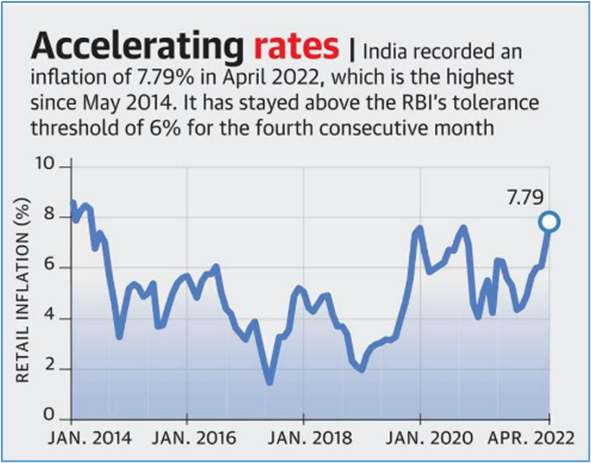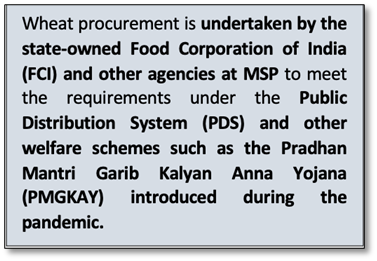Monday, 16th May 2022
Fall in India’s Forex Reserves and the Rupee
In News
India’s forex reserves have also dropped below $600 billion.
The fall of the Rupee
- India’s forex reserves have plunging by about $45 billion since September 3, 2021, when forex reserves stood at an all-time high of $642 billion.
- The Indian rupee hit an all-time low against the U.S. dollar this week weakening past the 77 rupees to a dollar mark and selling at 77.63 against the dollar.
- Many analysts expect the rupee to weaken further in the coming months to hit the 80 rupees to a dollar mark.
- In fact, the International Monetary Fund expects the rupee to weaken past the 94 rupees to a dollar mark by FY29.
Why did the Rupee fall?
- Stronger Dollar: US Dollar has gained 8 percent since the start of the year. Since March this year, the U.S. Federal Reserve has been raising its benchmark interest rate causing investors seeking higher returns to pull capital away from emerging markets such as India and back into the United States.
- Geopolitical risks: rupee has been under significant pressure ever since the disturbance of geopolitical situations owing to Russia's invasion of Ukraine.
- With crude oil prices soaring to record highs in wake of supply restrictions, India being the third largest importer of oil in world, witnessed a significant rise in its import bill.
- Domestic Inflation: Higher inflation in India suggests that the RBI has been creating rupees at a faster rate than the U.S. Federal Reserve has been creating dollars.
How fall in Rupee led to drop in Forex?
- The drop in India’s forex reserves is believed to be largely due to steps taken by the Reserve Bank of India to support the rupee.
- As a matter of policy, the Indian central bank has usually tried to slow down or smoothen, rather than reverse or prevent, the fall in exchange value of the rupee against the U.S. dollar.
- The drop in forex reserves may be due to a fall in the dollar value of assets held as reserves by the RBI.
- Foreign exchange reserves are assets denominated in a foreign currency that are held by a nation's central bank. These may include foreign currencies, bonds, treasury bills, and other government securities.
- The biggest contributor to this reserve is foreign currency assets followed by the gold, SDR, and reserve with the International Monetary Fund.

Sources:
- Explained | Why is there a fall in India’s foreign exchange reserves?
- India's foreign exchange reserves drop by $1.7 billion; hit 1-year low
- Three reasons why Rupee is falling against Dollar
- Explained: What led to record fall in rupee
- Rupee continues to fall to record lows and it might affect your food, education, healthcare and other expenses
- US dollar hits highest level in more than 2 years
Laws on Pardon and remission in India
In News
The Supreme Court has recently reserved orders on the question whether a Governor can refer the State government’s advice for granting remission to life convicts to the President for a decision.
About the News
- The court is examining the petition from A.G. Perarivalan, one of the life convicts in the Rajiv Gandhi assassination case whose release has been delayed after the Governor, instead of acting on the recommendation has referred it to the President.
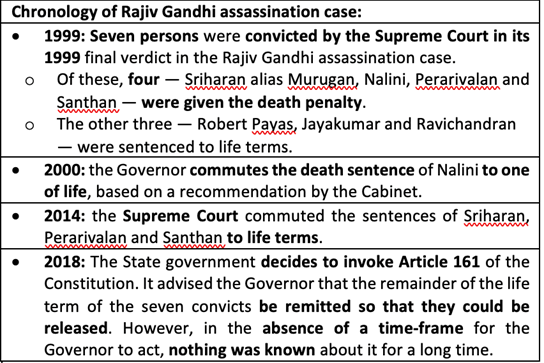
-
- The Tamil Nadu government, in 2018 has recommended the release of all seven convicts in the case under Article 161 of the Constitution.
- Under Article 72 of the constitution, only the President could consider a claim for pardon or remission, and not the State Governor, if the offence involved was based on a parliamentary law.
What are the laws governing pardon power in India?
- Clemency powers: Both the President and the Governor have been vested with sovereign power of pardon by the Constitution, commonly referred to as mercy or clemency power.
- Article 72: Under it the President can grant pardons, reprieves, respites or remissions of punishment or suspend, remit or commute the sentence of any person convicted of any offence in following cases:
- All cases where the punishment or sentence is by a court-martial,
- All cases where the punishment or sentence is for an offence under any law relating to the Union government’s executive power
- All cases of death sentences.
- Article 72: Under it the President can grant pardons, reprieves, respites or remissions of punishment or suspend, remit or commute the sentence of any person convicted of any offence in following cases:
- Limitation: It is also made clear that the President’s power will not in any way affect a Governor’s power to commute a death sentence.
- Article 161: A Governor can grant pardons, reprieves, respites or remissions of punishment, or suspend, remit or commute the sentence of anyone convicted under any law on a matter which comes under the State’s executive power.

Sources:
Early onset of monsoons
In News
The India Meteorological Department (IMD) has recently announced that the southwest monsoon is likely to set in over Kerala well ahead of its normal date, which will be the earliest onset of the monsoon over Kerala since 2009.
Is it unusual for the monsoon to hit the Kerala coast early?
Neither early nor late onset of the monsoon is unusual.

- In 2018 and 2017, the onset over Kerala occurred on May 29 and May 30 respectively.
- In 2010, onset was on May 31.
- Both in 2013 and 2020, the monsoon was exactly on time, hitting the Kerala coast on June 1.
- In the rest of the years going back to 2010, the onset was delayed.
Causes of an early monsoon
- The early onset of southwest monsoon over Kerala is attributed to the influence of the remnants of Cyclone Asani that triggered the cross-equatorial flow, a key factor for the seasonal rains.
- For instance, last year too, a cyclone – named Yaas had caused the timely arrival of monsoon in Andaman and Nicobar islands.
Does an early onset mean a good monsoon?
- The onset is just an event that happens during the progress of the monsoon over the Indian subcontinent.
- A delay of a few days, or perhaps the monsoon arriving a few days early, has no bearing on the quality or amount of rainfall, or its regional distribution across the country, during the monsoon season.
Does a delayed onset mean cascading delays across the country?
- A delay in onset over Kerala can potentially delay the arrival of the monsoon in other parts of the country.
- However, a delayed onset over Kerala does not automatically or invariably mean delays in the arrival of the monsoon over the entire country.
- The northward progression of the monsoon after it has hit the Kerala coast depends on a lot of local factors such as the creation of low pressure areas.
- Therefore, it is possible that despite a late onset over Kerala, other parts of the country start getting rain on time.
Source:
- Explained: What is the ‘onset’ of the monsoon, and what does an early onset over Kerala mean?
- What Causes An Early Monsoon And What Does It Mean For Indian Heatwave?
Image source:
Sikkim Statehood Day
On May 16, 1975 Sikkim became the 22nd state of India. Today, Sikkim remains significant from a strategic point of view, given its proximity to Tibet and the crucial Siliguri Corridor that connects India's north-eastern states with the rest of the country. It borders Tibet in the north and northeast, Bhutan in the east, Nepal in the west and West Bengal in the south.
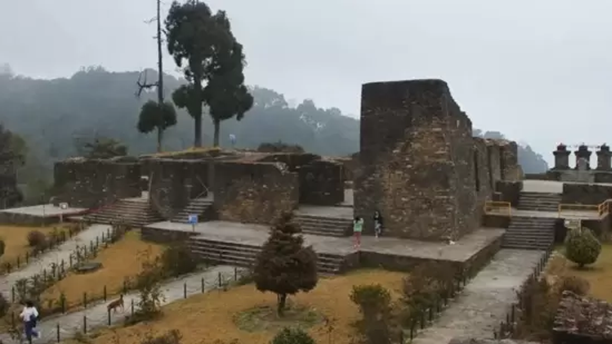
Sikkim is least populous and second smallest among the Indian states. Sikkim has become India’s first fully organic state by implementing organic practices on around 75,000 hectares of agricultural land.
Sources:
India-Maldives Relations
In News
Amid the recent spate of “India out” in Maldives, its President Ibrahim Mohammed Solih issued a decree banning protests against India.
About the India Out Campaign
- The India Out campaign began in 2020, when opposition parties targeted the ruling Maldivian Democratic Party (MDP) government for its growing proximity to India.
- Former President Abdulla Yameen is leading the campaign under whose presidency (2013-18), Maldives’ foreign policy took a distinctly pro-China turn.
- The Protestors have claimed that New Delhi maintains a military presence in Maldives, something the Maldives government denies. This has become the focus of the campaign.
- Under existing agreements, the campaign claims that Indian military vessels could enter the Maldives’ Exclusive Economic Zone by simply informing Maldivian authorities rather than seeking their permission.
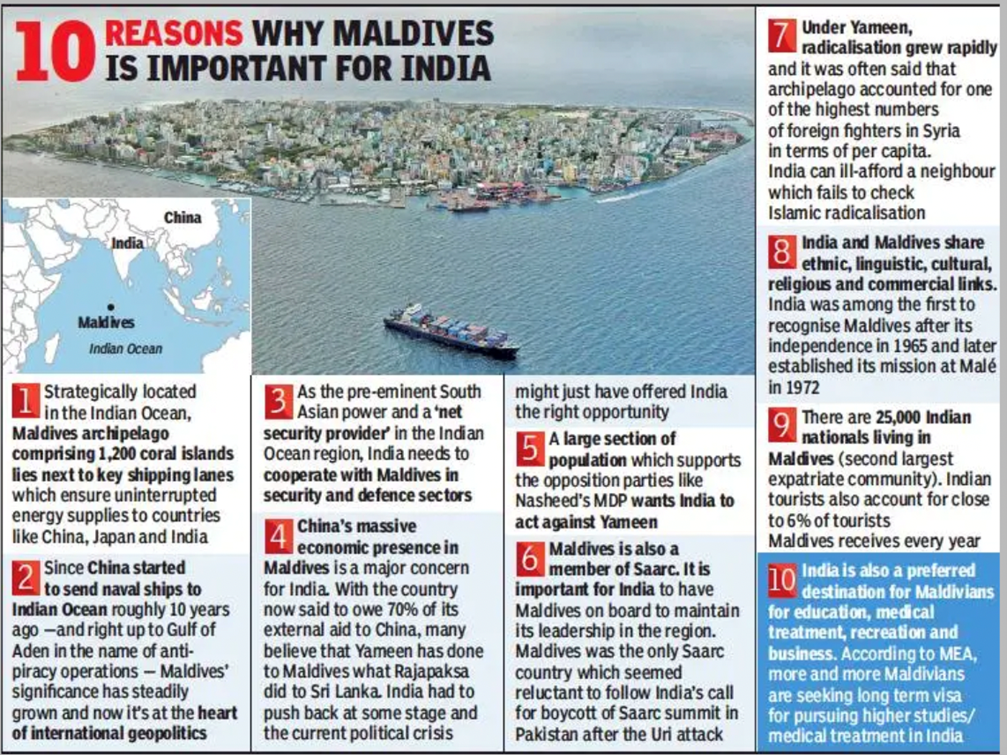
History of India-Maldives Relations
- India and Maldives share ethnic, linguistic, cultural, religious and commercial links steeped in antiquity and enjoy close, cordial and multi-dimensional relations.
- India was among the first to recognise Maldives after its independence in 1965 and to establish diplomatic relations with the country.
- India’s prompt assistance during the 1988 coup attempt, led to development of trust and long‐term and friendly bilateral relations with the Maldives.
Components of India-Maldives Relations
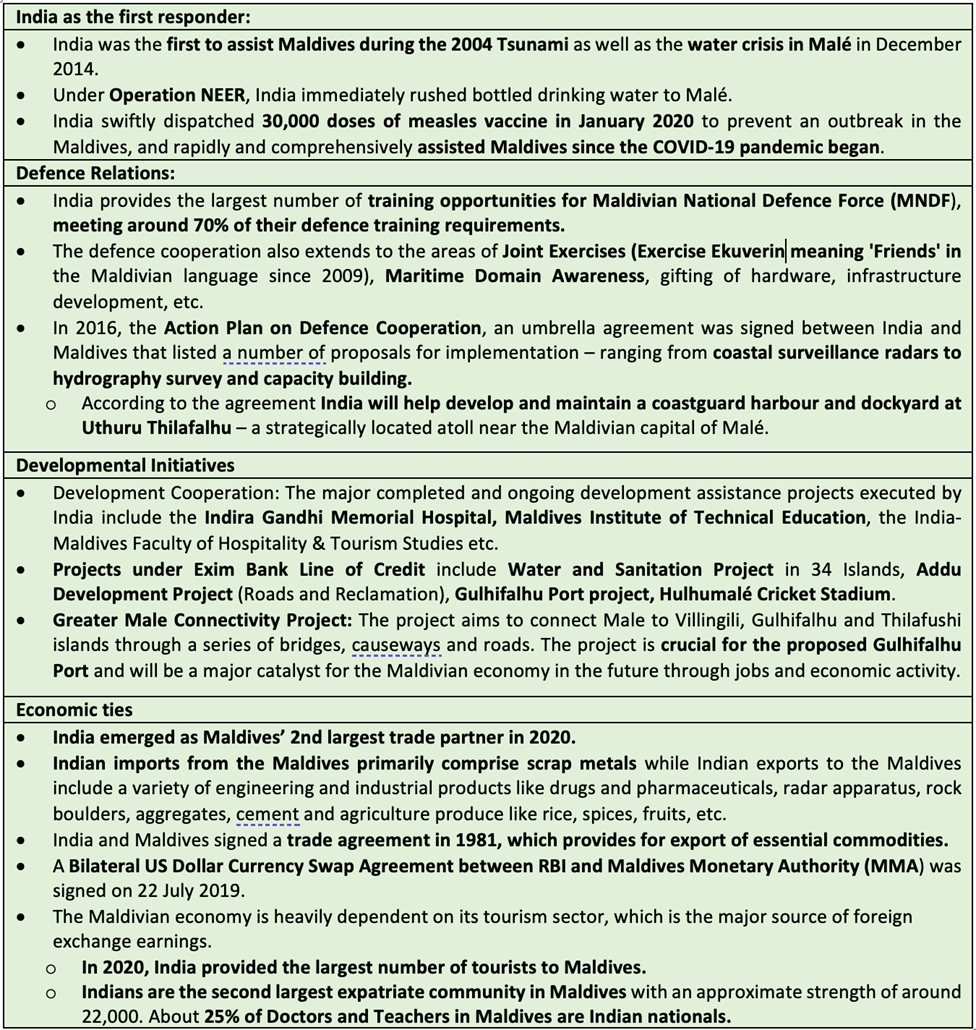
Strategic Importance of Maldives for India
- Maldives is one of the world’s most geographically dispersed countries straddling a 960-km-long submarine ridge running north to south and which forms a wall in the middle of the Indian Ocean.
- Located at the southern and northern parts of this island chain are the only two passages through which ships can pass safely. Both these sea lanes of communication (SLOCs) are critical for maritime trade flow between the Gulf of Aden and Gulf of Hormuz in West Asia and the Strait of Malacca in Southeast Asia.
- These are of vital importance for India since nearly 50 per cent of India’s external trade and 80 per cent of her energy imports transit these westward SLOCs in the Arabian Sea.
- In addition, Maldives is an important partner in India’s role as the net security provider in the Indian Ocean Region.
- China’s strategic interests and logistical limitations in the Indian Ocean have prompted it to increase its presence in the Indian Ocean, including in Maldives.
- A favourable and positive maritime environment in the Indian Ocean is essential for the fulfilment of India’s developmental priority. Thus, India continuously aims at promoting an ever-expanding area of peace and stability around it.
Conclusion: The Maldives relationship with India has habitually oscillated between support and opposition. Currently certain domestic elements in the Maldives have skillfully attempted to drive the relationship to a nadir by driving anti-India sentiments. Unfortunately, on this occasion India has yet again been a victim of the internal political situation in the Maldives. India plays a critical role in economic, defense, and humanitarian sectors in the Maldives and will continue to do so despite the campaign. Only a change in political leadership and government might affect the capacity of India’s affairs with the Maldives.
Question: Maldives is strategically important for India. Discuss the relations between India and Maldives in this context.
Sources:
- Maldives issues decree to ban anti-India protests
- Maldives: India first or India out?
- India – Maldives Relations
- India-Maldives Relations
- India-Maldives Ties Caught in Archipelago’s Domestic Politics
- Implications of Political Dissonance in the Maldives
- Narendra Shekhawat asked: What is the geo-strategic importance of Maldives to India?
- High Commission of India Malé; India‐Maldives Bilateral Relations
- The Maldives’ ‘India Out’ Campaign:
Image: Times of India
Rock Paintings in Telangana
This is image of the Prehistoric rock paintings recently found in Telangana.
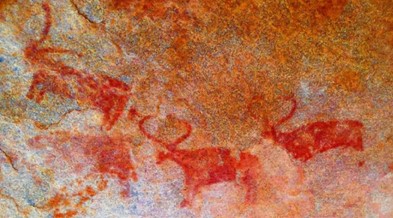
History enthusiasts believe they date back 10k-30k years. The microlithic tools, rock art style, and the items and bisons in the paintings indicate that the rock art site belongs to the microlithic age. This is a new site that is going to be added to the list of Telangana rock art sites. These rock-art sites are the first documentation of experiences man encountered as a hunter-gatherer.
Source:
iFLOWS
- Context: Citizens of Mumbai would be able to access the state-of-the-art flood warning system-iFLOWS from this monsoon season.
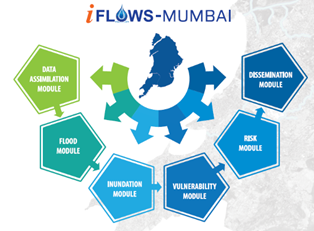
- iFLOWS is an Integrated Flood Warning System, that relays alerts of possible flood-prone areas between 6 and 72 hours in advance.
- It is a joint initiative between the Ministry of Earth Sciences (MoES) and Brihanmumbai Municipal Corporation (BMC).
- The system is expected to:
- Provide information, including the likely height the floodwater could attain, and location-wise problem areas across all 24 wards.
- Calculate the vulnerability along with the risk of elements exposed to flood.
- Provide alerts on rainfall, tide levels, and storm surge for low-lying areas, thereby minimising the damage from cyclones and heavy rain events.
- The primary source for the system is the amount of rainfall, along with factors such as tidal waves and storm tides for its flood assessments.
Source:
- Citizens to get access to advanced flood warning system iFLOWS this monsoon
- IFLOWS-Mumbai: How it works, and how it will benefit the Maximum City
Image source:
'Swathi' weapon-locating radars
- Context: The Indian Army has put up a proposal to the Defence Ministry for buying 12 Swathi Weapon-locating radars (WLR).
- It is an indigenously developed, coherent, electronically scanned phased array radar.
- It provides fast, automatic, and accurate location of enemy weapons like Mortars, shells and rockets within a range of 50km.

- They can also simultaneously detect multiple projectiles fired from different weapons at different locations.
- The radar uses advanced signal processing techniques for detection and tracking projectiles in the presence of ground, weather clutter and other forms of interference.
- The system of the radar is designed to survive physical rigours of battlefield and soft hostile electronic warfare.
- It has been developed by DRDO and built by Bharat Electronics Limited.
- It will be of great strategic significance as the Indian Army has been using the radars for its operations along the Line of Control in Jammu and Kashmir.
Source:
- Indian Army to buy 12 more Made-in-India 'Swathi' weapon-locating radars for China border
- DRDO develops 6 more location radar weapons SWATHI, to be procured by Indian Army soon
- Weapon Locating Radar (WLR)
Image source:
Buddha Purnima
- Context: The Prime Minister will be visiting Lumbini in Nepal on the occasion of Buddha Purnima.
- Buddha Purnima is celebrated as the birth anniversary of Gautama Buddha, a spiritual teacher on whose teachings Buddhism was founded.

- Siddhartha Gautama, later came to be known as Gautama Buddha, was born between 563-483 BC in Lumbini, Nepal.
- He died at the age of 80 at Kushinagar, Uttar Pradesh.
- Buddha Purnima, is celebrated on the full moon day of the Baisakh month (April/May) every year, to mark the day on which Gautama Buddha is believed to have obtained enlightenment.
- Buddha obtained enlightenment at Bodh Gaya and he first taught Dharma at Sarnath.
- Kushinagar, Lumbini and Sarnath are other three related important pilgrimage sites.
- The festival is celebrated as Vesak in Sri Lanka, Indonesia, Myanmar, Cambodia, Tibet, and Mongolia.
- On this day, people offer prayers to Lord Buddha and seek knowledge and Wisdom. They also donate alms to the needy, meditate, observe fast and read Holy Scripture of Buddhist religion on this day.
Source:
Image source:
Sagittarius A
- Context: Astronomers have recently unveiled the first image of the supermassive black hole 'Sagittarius A*.
- Sagittarius A* is a supermassive black hole at the centre of the Milky Way Galaxy, and is located in the constellation Sagittarius.

- Nearly all galaxies have these giant black holes at their centre, where light and matter cannot escape, making it extremely hard to get images of them.
- Sagittarius A* gives further support to the idea that the compact object at the centre of our galaxy is indeed a black hole.
- It is at 26,000 light-years away from our solar system, and has a mass 4.3 million times that of the sun.
- It strengthens Einstein’s general theory of relativity that a point in space where matter is so compressed as to create a gravity field from which even light cannot escape.
- The black hole was named in the 1980s due to its proximity to the Sagittarius constellation in the sky, and was estimated to be 26 million kilometres in diameter.
- The cloud of gas surrounding the Black holes are usually measured to infer the images within.
- The image has been revealed by the Event Horizon Telescope (EHT)
Source:
- Sagittarius A*: How did scientists photograph the black hole at the heart of the Milky Way?
- Meet Sagittarius A*! Scientists Produce First-Ever Images of Supermassive Black Hole at Centre of Our Galaxy Milky Way
- Astronomers reveal first image of the black hole - Sagittarius A*- at the heart of our galaxy
Image Source:
To tackle Covid, lessons from flood preparedness: Indian Expresss
Essence: As the count of covid cases are increasing, how to respond to it has become another big question. Author suggests a graded response to covid just as we do for flood protection. Timely forecasting of future rate of increase of covid cases is a critical component, just as rain forecast forms bedrock of flood management. Putting in place public health infrastructure and making people aware about dos and don'ts in case of covid outbreak will go a long way. Just as a normal rainfall does not lead to disruption in public life, slight rise in covid cases should not lead to restrictions on movement and closure of offices. Making available booster doses to more vulnerable sections and encouraging people to mask up will help more than any coercive step.
Local bodies and voluntary associations should be empowered to deal with local outbreaks. Finally inculcating a sense of civic duty in people to not to infect others by irresponsible actions will help communities stay safe.
Why should you read this article?
- To understand models to deal with rising covid cases.
- To appreciate flood management methodology which can be used in GS-1 and GS-3 (Disaster management).
Source:
The road to safety: The Hindu
Essence: The editorial speaks on the issue of road safety in India. India accounts for the largest number of road deaths in accidents and 1/3rd of these accident deaths happen in big cities. Most of the victims are pedestrians, cyclists, or 2-wheeler drivers. Half of these avoidable deaths happen due to collision with buses and trucks. And 75% of those who lose lives are those in youth and middle age population.
To improve on such issues, Delhi traffic police has started to use technology, enforce mandated guidelines and compliances. Lane driving, acquisition of driving license, automated speed meters, encroachment/parking removal from roads have been introduced as reform measures. Since Delhi has the highest number of per capita registrations of personal vehicles (110 cars per 1000 people), as compared to national average of 25, these reforms are needed. Also, India needs to adopt Mobility as a Service (MaaS) for urban commutation.
Why should you read this article?
- To know the cause of road accidents.
- To understand the best practices being followed to avert road crisis.
Source:
PARI: Diarrhoea Doll
Background
- PARI, also known as Diarrhoea Doll, is an educational tool developed by BBC Media Action that is used at Village Health and Sanitation Days (VHSNDs) in Bihar.
- The Diarrhoea Doll, an educational instrument that teaches mothers in rural India about diarrhoea, was launched in 100 Bihar Village Health & Nutrition Centres and has since been scaled up to 600 Primary Health Centres.

About PARI The Doll that Solves Diarrhoeal Woes
- Under the Ananya Initiative, financed by the Bill & Melinda Gates Foundation, BBC Media Action is executing a five-year behaviour change communication campaign to promote mother and child health.
- Mothers are hesitant to provide fluids/ORS to their children because they believe in the 'leaky bucket' theory, which can be catastrophic for infants who suffer from dehydration and mineral loss.
- PARI is an inflatable doll that can expand and compress when filled or released with fluids. The health worker fills Pari with water from the top inlet to illustrate how it works. The doll expands to resemble a healthy child.
- PARI's doll house includes the Diarrhoea Kit, which comprises of a 1 litre bottle, a glass, a spoon, and ORS and zinc sachets.
Quote: “You've probably been asked to care about things like HIV/AIDS or T.B. or measles, but diarrhoea kills more children than all those three things put together. It's a very potent weapon of mass destruction.”-Rose George
Source:
Share the article
Get Latest Updates on Offers, Event dates, and free Mentorship sessions.

Get in touch with our Expert Academic Counsellors 👋
FAQs
UPSC Daily Current Affairs focuses on learning current events on a daily basis. An aspirant needs to study regular and updated information about current events, news, and relevant topics that are important for UPSC aspirants. It covers national and international affairs, government policies, socio-economic issues, science and technology advancements, and more.
UPSC Daily Current Affairs provides aspirants with a concise and comprehensive overview of the latest happenings and developments across various fields. It helps aspirants stay updated with current affairs and provides them with valuable insights and analysis, which are essential for answering questions in the UPSC examinations. It enhances their knowledge, analytical skills, and ability to connect current affairs with the UPSC syllabus.
UPSC Daily Current Affairs covers a wide range of topics, including politics, economics, science and technology, environment, social issues, governance, international relations, and more. It offers news summaries, in-depth analyses, editorials, opinion pieces, and relevant study materials. It also provides practice questions and quizzes to help aspirants test their understanding of current affairs.
Edukemy's UPSC Daily Current Affairs can be accessed through:
- UPSC Daily Current Affairs can be accessed through Current Affairs tab at the top of the Main Page of Edukemy.
- Edukemy Mobile app: The Daily Current Affairs can also be access through Edukemy Mobile App.
- Social media: Follow Edukemy’s official social media accounts or pages that provide UPSC Daily Current Affairs updates, including Facebook, Twitter, or Telegram channels.

